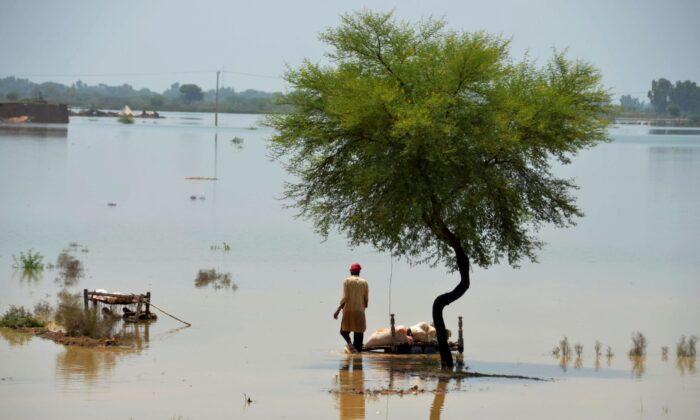ISLAMABAD—Flash floods triggered by heavy monsoon rains across much of Pakistan have killed nearly 1,000 people and injured and displaced thousands more since mid-June, officials said Saturday.
The new death toll came a day after Prime Minister Shahbaz Sharif asked for international help in battling deadly flood damage in the impoverished Islamic nation.
The monsoon season, which began in June, has lashed Pakistan with particularly heavy rains this year and rescuers have struggled to evacuate thousands of marooned people from flood-hit areas. The crisis has forced the government to declare a state of emergency.
In northwestern Khyber Pakhtunkhwa Province, flooding destroyed the gates of a major water control system at the Swat River, leading to flooding in the districts of Charsadda and Nowshera, said Sania Safi, a top administrator in Charsadda.
“We preempted the situation and warned and forced hesitating residents to leave their homes for safety and move to relief camps established at government buildings in safe places,” she said.
Safi said there was concern of further rising of the Swat and Kabul rivers, adding to the misery of residents who have already suffered the loss of lives and property.
In Nowshera district, local administrator Quratul Ain Wazir said flood waters submerged streets before the gushing waters headed toward low-lying areas.
“Our administration has evacuated many people and taken others to relief camps where government provided beds and food in safe buildings,“ she said. ... ”We will use police to force those hesitant to leave their homes.”
Information Minister Maryam Aurangzeb said soldiers and rescue organizations were helping people to reach safety in many districts of southern Sindh, northwestern Khyber Pakhtunkhwa, eastern Punjab, and southwestern Baluchistan Provinces.
“Government has sanctioned sufficient funds to financially compensate the affected people and we will not leave our people alone in this tough time,” she said.
Aurangzeb asked wealthy people and relief organizations to come forward with aid to help flood-affected Pakistanis.
In response to Sharif’s appeal for international aid, the United Nations planned a $160 million flash appeal for donations, according to Foreign Ministry spokesman Asim Iftikhar. He said in his weekly briefing Friday that the appeal will be launched Aug. 30.
The picturesque Kalam Valley in Khyber Pakhtunkhwa Province is one of the areas most affected by the rains and flooding. Waters from overflowing rivers swept away entire buildings, including an iconic hotel.
“The situation is pretty serious as we don’t have any road link left with the rest of the province, we don’t have electricity, gas, and communications network and no relief is reaching here,” said Muzaffar Khan, whose grocery store was swept away along with many other shops.
Thousands whose homes were swept away now live in tents, miles away from their inundated villages and towns, after being rescued by soldiers, local disaster workers, and volunteers, authorities said.
In Baluchistan, Asadullah Nasir, a spokesperson at the provincial disaster management authority said all 34 districts of the impoverished province were badly affected due to the heavy rains and subsequent flooding. He said road networks were destroyed and bridges washed away and relief is possible only with helicopters, which are not often able to operate because of bad weather. He said provincial officials have confirmed 235 deaths but the number was expected to increase significantly after communications are restored.
The National Disaster Management Authority in its latest overnight report said 45 people were killed in flood-related incidents from Friday to Saturday. That brought the death toll since mid-June to 982 with 1,456 injured.
Monsoon rains were expected to continue this week, mainly in the south and southwest. The season usually runs from July to mid September in Pakistan.
Heavy rains and subsequent flash floods have damaged bridges, roads network across Pakistan, disrupting the supply of fruit and vegetables to markets and causing a hike in prices.





